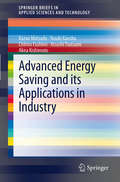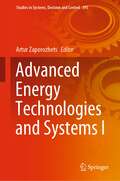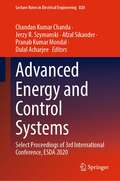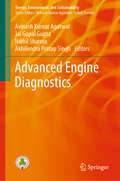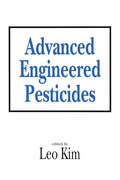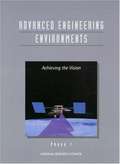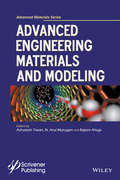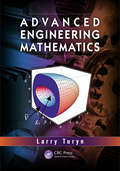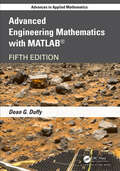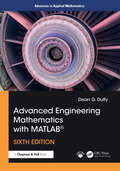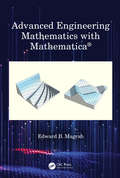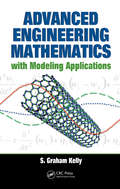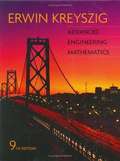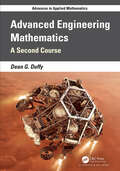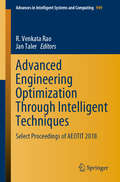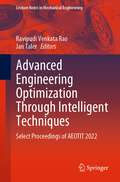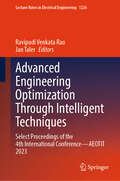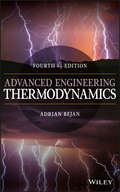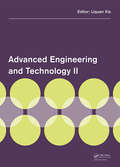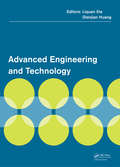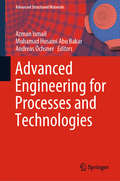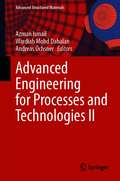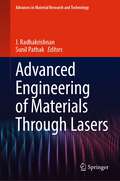- Table View
- List View
Advanced Energy Saving and its Applications in Industry (SpringerBriefs in Applied Sciences and Technology)
by Atsushi Tsutsumi Akira Kishimoto Chihiro Fushimi Yasuki Kansha Kazuo MatsudaThe conventional approach for energy saving in a process system is to maximize heat recovery without changing any process conditions by using pinch technology. "Self-heat recuperation technology" was developed to achieve further energy saving in the process system by eliminating the necessity for any external heat input, such as firing or imported steam. Advanced Energy Saving and its Applications in Industry introduces the concept of self-heat recuperation and the application of such technology to a wide range of processes from heavy chemical complexes to other processes such as drying and gas separation processes, which require heating and cooling during operation. Conventional energy saving items in a utility system are applied and implemented based on a single site approach, however, when looking at heavy chemical complexes, it was apparent that the low-grade heat discharged as waste from a refinery could also be used in an adjacent petrochemical plant. There could therefore be a large energy saving potential by utilizing the surplus heat across the sites. Advanced Energy Saving and its Applications in Industry assesses conventional approaches to industrial energy saving and explains and outlines new methods to provide even greater energy saving potential. Advanced Energy Saving and its Applications in Industry provides a key resource and research tool for all those involved in developing the energy efficiency of industrial processes. Researchers, industry professionals and even students with an interest in green engineering will find the summaries of the conventional and suggested new methods useful when attempting to advance further development within this field.
Advanced Energy Technologies and Systems I (Studies in Systems, Decision and Control #395)
by Artur ZaporozhetsThis book focuses on modern technologies and systems for solving problems in the energy sector. It is shown that bioenergy is one of the promising areas of energy development. The book collected the experience of scientists from many countries in the research of renewable energy. The advantages of renewable energy are general availability, renewability, environmental friendliness. The analysis carried out by the authors shows the current state of renewable energy in the world, its trends and prospects. New measuring systems are presented, which can become the basis for measuring the thermal characteristics of various types of fuels, including biofuels, insulating materials, enclosing structures, etc. System for monitoring of grainy biomass comminution with the use of genetic algorithms has been presented and described. New technologies for the construction of power plants based on renewable energy sources have been proposed and investigated.
Advanced Energy and Control Systems: Select Proceedings of 3rd International Conference, ESDA 2020 (Lecture Notes in Electrical Engineering #820)
by Afzal Sikander Dulal Acharjee Chandan Kumar Chanda Pranab Kumar Mondal Jerzy R. SzymanskiThis book gathers selected research papers presented at the Third International Conference on Energy Systems, Drives, and Automations (ESDA 2020). It covers a broad range of topics in the fields of renewable energy, power management, drive systems for electrical machines, and automation. In a spam of about a few interesting articles, effort had gone in to critically discuss about the control system, energy management and distribution in a unified approach common to electrical, Control and mechanical engineering. This book also comprehensively discusses a variety of related tools and techniques and will be a valuable resource for researchers, professionals, and students in electrical and mechanical engineering disciplines.
Advanced Engine Diagnostics (Energy, Environment, and Sustainability)
by Avinash Kumar Agarwal Akhilendra Pratap Singh Jai Gopal Gupta Nikhil SharmaThis book describes the discusses advanced fuels and combustion, emission control techniques, after-treatment systems, simulations and fault diagnostics, including discussions on different engine diagnostic techniques such as particle image velocimetry (PIV), phase Doppler interferometry (PDI), laser ignition. This volume bridges the gap between basic concepts and advanced research in internal combustion engine diagnostics, making it a useful reference for both students and researchers whose work focuses on achieving higher fuel efficiency and lowering emissions.
Advanced Engineered Pesticides
by Leo KimEmphasizing the need for more integrated pest management programmes, this work presents the development and state-of-the-art technology of genetically-engineered microbes, viruses, bacterial toxins and plants. Throughout, both environmental and regulatory concerns are addressed.
Advanced Engineering Dynamics
by Jerry H. GinsbergThis text offers a clear and refreshing exposition of the dynamics of mechanical systems from an engineering perspective. The author thoroughly covers basic concepts and applies them in a systematic manner to solve problems in mechanical systems with applications to engineering. Numerous illustrative examples accompany all theoretical discussions, and each chapter offers a wealth of homework problems. The treatment of the kinematics of particles and rigid bodies is extensive. In this new edition the author has revised and reorganized sections to enhance understanding of physical principles, and he has modified and added examples, as well as homework problems. The new edition also contains a thorough development of computational methods for solving the differential equations of motion for constrained systems. Seniors and graduate students in engineering will find this book to be extremely useful. Solutions manual available.
Advanced Engineering Environments: Achieving the Vision
by National Research CouncilReport on Advanced Engineering Environments.
Advanced Engineering Materials and Modeling
by Ashutosh Tiwari N. Arul Murugan Rajeev AhujaThe engineering of materials with advanced features is driving the research towards the design of innovative materials with high performances. New materials often deliver the best solution for structural applications, precisely contributing towards the finest combination of mechanical properties and low weight. The mimicking of nature's principles lead to a new class of structural materials including biomimetic composites, natural hierarchical materials and smart materials. Meanwhile, computational modeling approaches are the valuable tools complementary to experimental techniques and provide significant information at the microscopic level and explain the properties of materials and their very existence. The modeling also provides useful insights to possible strategies to design and fabricate materials with novel and improved properties. The book brings together these two fascinating areas and offers a comprehensive view of cutting-edge research on materials interfaces and technologies the engineering materials. The topics covered in this book are divided into 2 parts" Engineering of Materials, Characterizations & Applications and Computational Modeling of Materials. The chapters include the following: Mechanical and resistance behavior of structural glass beams Nanocrystalline metal carbides - microstructure characterization SMA-reinforced laminated glass panel Sustainable sugarcane bagasse cellulose for papermaking Electrospun scaffolds for cardiac tissue engineering Bio-inspired composites Density functional theory for studying extended systems First principles based approaches for modeling materials Computer aided materials design Computational materials for stochastic electromagnets Computational methods for thermal analysis of heterogeneous materials Modelling of resistive bilayer structures Modeling tunneling of superluminal photons through Brain Microtubules Computer aided surgical workflow modeling Displaced multiwavelets and splitting algorithms
Advanced Engineering Mathematics
by Lawrence TurynBeginning with linear algebra and later expanding into calculus of variations, Advanced Engineering Mathematics provides accessible and comprehensive mathematical preparation for advanced undergraduate and beginning graduate students taking engineering courses. This book offers a review of standard mathematics coursework while effectively integrati
Advanced Engineering Mathematics with MATLAB (Advances in Applied Mathematics)
by Dean G. DuffyIn the four previous editions the author presented a text firmly grounded in the mathematics that engineers and scientists must understand and know how to use. Tapping into decades of teaching at the US Navy Academy and the US Military Academy and serving for twenty-five years at (NASA) Goddard Space Flight, he combines a teaching and practical experience that is rare among authors of advanced engineering mathematics books. This edition offers a smaller, easier to read, and useful version of this classic textbook. While competing textbooks continue to grow, the book presents a slimmer, more concise option. Instructors and students alike are rejecting the encyclopedic tome with its higher and higher price aimed at undergraduates. To assist in the choice of topics included in this new edition, the author reviewed the syllabi of various engineering mathematics courses that are taught at a wide variety of schools. Due to time constraints an instructor can select perhaps three to four topics from the book, the most likely being ordinary differential equations, Laplace transforms, Fourier series and separation of variables to solve the wave, heat, or Laplace's equation. Laplace transforms are occasionally replaced by linear algebra or vector calculus. Sturm-Liouville problem and special functions (Legendre and Bessel functions) are included for completeness. Topics such as z-transforms and complex variables are now offered in a companion book, Advanced Engineering Mathematics: A Second Course by the same author. MATLAB is still employed to reinforce the concepts that are taught. Of course, this Edition continues to offer a wealth of examples and applications from the scientific and engineering literature, a highlight of previous editions. Worked solutions are given in the back of the book.
Advanced Engineering Mathematics with MATLAB® (Advances in Applied Mathematics)
by Dean G. DuffyIn the five previous editions of Advanced Engineering Mathematics with MATLAB®, the author presented a text firmly grounded in mathematics that engineers and scientists must understand and know how to use. Tapping into decades of teaching at the US Navy Academy and the US Military Academy and serving for twenty-five years at (NASA) Goddard Space Flight, he combines teaching and practical experience that is rare among authors of advanced engineering mathematics books.This edition continues to refine a smaller, easier to read, and useful version of this classic textbook. While competing textbooks continue to grow, the book presents a slimmer, more practical option to align with the expectations of today’s students.The new edition of the author’s classic textbook continues on a path to creating the best possible learning resource for instructors and students alike. Through extensive class testing over five previous editions, including the author’s current course at the US Naval Academy, the book has been steadily improved.The primary mission of this edition is to dramatically increase the quality and quantity of examples and problems, especially in the chapters on differential equations and Laplace transforms. The chapters on differential equations, linear algebra, Fourier series, and Laplace transforms have seen the greatest changes. Of course, this edition continues to offer a wealth of examples and applications from scientific and engineering literature, a highlight of previous editions.MATLAB® remains central to the presentation and is employed to reinforce the concepts that are taught. Worked solutions are given in the back of the book. An Instructor’s Solutions Manual is also available.
Advanced Engineering Mathematics with Mathematica
by Edward B. MagrabAdvanced Engineering Mathematics with Mathematica® presents advanced analytical solution methods that are used to solve boundary-value problems in engineering and integrates these methods with Mathematica® procedures. It emphasizes the Sturm–Liouville system and the generation and application of orthogonal functions, which are used by the separation of variables method to solve partial differential equations. It introduces the relevant aspects of complex variables, matrices and determinants, Fourier series and transforms, solution techniques for ordinary differential equations, the Laplace transform, and procedures to make ordinary and partial differential equations used in engineering non-dimensional. To show the diverse applications of the material, numerous and widely varied solved boundary value problems are presented.
Advanced Engineering Mathematics with Modeling Applications
by S. Graham KellyA graduate level text, this book presents a unique combination of theoretical mathematics and engineering applications. It demonstrates the relationship between advanced mathematics and engineering principles, introduces engineering mathematics at a theoretical level, and includes functional analysis topics such as vector spaces, inner products, and norms and develops advanced mathematical methods from this foundation. The author does not focus on proving theorems but on the application of the theorems to the solution of engineering problems. In sum, the book provides an overview of the principles and techniques of advanced mathematics as applied to mechanical engineering problems.
Advanced Engineering Mathematics, 9th Edition
by Erwin KreyszigThis new edition continues the tradition of providing instructors and students with a comprehensive and up-to-date resource for teaching and learning engineering mathematics, that is, applied mathematics for engineers and physicists, mathematicians and computer scientists, as well as members of other disciplines. A course in elementary calculus is the sole prerequisite.
Advanced Engineering Mathematics: A Second Course with MatLab (Advances in Applied Mathematics)
by Dean G. DuffyThrough four previous editions of Advanced Engineering Mathematics with MATLAB, the author presented a wide variety of topics needed by today's engineers. The fifth edition of that book, available now, has been broken into two parts: topics currently needed in mathematics courses and a new stand-alone volume presenting topics not often included in these courses and consequently unknown to engineering students and many professionals. The overall structure of this new book consists of two parts: transform methods and random processes. Built upon a foundation of applied complex variables, the first part covers advanced transform methods, as well as z-transforms and Hilbert transforms--transforms of particular interest to systems, communication, and electrical engineers. This portion concludes with Green's function, a powerful method of analyzing systems. The second portion presents random processes--processes that more accurately model physical and biological engineering. Of particular interest is the inclusion of stochastic calculus. The author continues to offer a wealth of examples and applications from the scientific and engineering literature, a highlight of his previous books. As before, theory is presented first, then examples, and then drill problems. Answers are given in the back of the book. This book is all about the future: The purpose of this book is not only to educate the present generation of engineers but also the next. "The main strength is the text is written from an engineering perspective. The majority of my students are engineers. The physical examples are related to problems of interest to the engineering students." --Lea Jenkins, Clemson University
Advanced Engineering Optimization Through Intelligent Techniques: Select Proceedings of AEOTIT 2018 (Advances in Intelligent Systems and Computing #949)
by R. Venkata Rao Jan TalerThis book comprises select peer-reviewed papers presented at the International Conference on Advanced Engineering Optimization Through Intelligent Techniques (AEOTIT) 2018. The book combines contributions from academics and industry professionals, and covers advanced optimization techniques across all major engineering disciplines like mechanical, manufacturing, civil, automobile, electrical, chemical, computer and electronics engineering. Different optimization techniques and algorithms such as genetic algorithm (GA), differential evolution (DE), simulated annealing (SA), particle swarm optimization (PSO), artificial bee colony (ABC) algorithm, artificial immune algorithm (AIA), teaching-learning-based optimization (TLBO) algorithm and many other latest meta-heuristic techniques and their applications are discussed. This book will serve as a valuable reference for students, researchers and practitioners and help them in solving a wide range of optimization problems.
Advanced Engineering Optimization Through Intelligent Techniques: Select Proceedings of AEOTIT 2022 (Lecture Notes in Mechanical Engineering)
by Ravipudi Venkata Rao Jan TalerThis book comprises peer-reviewed papers presented at the International Conference on Advanced Engineering Optimization Through Intelligent Techniques (AEOTIT) 2022. The book combines contributions from academics and industry professionals and covers advanced optimization techniques across all major engineering disciplines like mechanical, manufacturing, civil, automobile, electrical, chemical, computer, and electronics engineering. The book discusses different optimization techniques and algorithms such as genetic algorithm, non-dominated sorting genetic algorithm-II, and III, differential search, particle swarm optimization, fruit fly algorithm, cuckoo search, teaching–learning-based optimization algorithm, grey wolf optimization, Jaya algorithm, Rao algorithms, and many other latest meta-heuristic techniques and their applications. Various multi-attribute decision-making methods such as AHP, TOPSIS, ELECTRE, PROMETHEE, DEMATEL, R-method, fuzzy logic, and their applications are also discussed. This book serves as a valuable reference for students, researchers, and practitioners and helps them in solving a wide range of optimization problems.
Advanced Engineering Optimization Through Intelligent Techniques: Select Proceedings of the 4th International Conference—AEOTIT 2023 (Lecture Notes in Electrical Engineering #1226)
by Ravipudi Venkata Rao Jan TalerThis book comprises peer-reviewed papers presented at the 4th International Conference on Advanced Engineering Optimization Through Intelligent Techniques (AEOTIT) 2023. The book combines contributions from academics and industry professionals and covers advanced optimization techniques across all major engineering disciplines like mechanical, manufacturing, civil, electrical, chemical, computer, and electronics engineering. The book discusses different optimization techniques and algorithms such as genetic algorithm, non-dominated sorting genetic algorithm-II, and III, particle swarm optimization, gravitational search algorithm, ant lion optimization, dragonfly algorithm, teaching–learning-based optimization algorithm, grey wolf optimization, Jaya algorithm, Rao algorithms, many other latest meta-heuristic techniques, machine learning algorithms, and their applications. Various multi-attribute decision-making methods such as AHP, TOPSIS, PROMETHEE, desirability function, SWARA, R-method, BHARAT method, Taguchi method, fuzzy logic, and their applications are also discussed. This book serves as a valuable reference for students, researchers, and practitioners and helps them in solving a wide range of optimization problems.
Advanced Engineering Thermodynamics
by Adrian BejanAn advanced, practical approach to the first and second laws of thermodynamics Advanced Engineering Thermodynamics bridges the gap between engineering applications and the first and second laws of thermodynamics. Going beyond the basic coverage offered by most textbooks, this authoritative treatment delves into the advanced topics of energy and work as they relate to various engineering fields. This practical approach describes real-world applications of thermodynamics concepts, including solar energy, refrigeration, air conditioning, thermofluid design, chemical design, constructal design, and more. This new fourth edition has been updated and expanded to include current developments in energy storage, distributed energy systems, entropy minimization, and industrial applications, linking new technologies in sustainability to fundamental thermodynamics concepts. Worked problems have been added to help students follow the thought processes behind various applications, and additional homework problems give them the opportunity to gauge their knowledge. The growing demand for sustainability and energy efficiency has shined a spotlight on the real-world applications of thermodynamics. This book helps future engineers make the fundamental connections, and develop a clear understanding of this complex subject. Delve deeper into the engineering applications of thermodynamics Work problems directly applicable to engineering fields Integrate thermodynamics concepts into sustainability design and policy Understand the thermodynamics of emerging energy technologies Condensed introductory chapters allow students to quickly review the fundamentals before diving right into practical applications. Designed expressly for engineering students, this book offers a clear, targeted treatment of thermodynamics topics with detailed discussion and authoritative guidance toward even the most complex concepts. Advanced Engineering Thermodynamics is the definitive modern treatment of energy and work for today's newest engineers.
Advanced Engineering and Sustainable Solutions (Advanced Structured Materials #228)
by Andreas Öchsner Azman Ismail Ashok Kumar Pandey Fatin Nur Zulkipli Deepak Kumar Singh Saurabh SambhavThis book is a comprehensive collection of cutting-edge research that addresses some of the most pressing challenges in modern engineering and applied sciences. This book features 26 chapters, each delving into innovative methodologies, advanced techniques, and sustainable solutions across a diverse range of disciplines. Each chapter presents rigorous analysis, practical applications, and forward-thinking solutions, making this book an essential resource for researchers, engineers, and professionals seeking to expand their knowledge and contribute to the advancement of sustainable technologies in their respective fields.
Advanced Engineering and Technology II: Proceedings of the 2nd Annual Congress on Advanced Engineering and Technology (CAET 2015), Hong Kong, 4-5 April 2015
by Liquan XieAdvanced Engineering and Technology II collects recent essential ideas and advanced techniques to overcome the current engineering issues in civil engineering, environmental engineering, water science and hydraulic engineering, energy and chemical engineering, and other related fields. The 60 technical papers from the 2nd Annual Congress on Advance
Advanced Engineering and Technology: Proceedings of the 2014 Annual Congress on Advanced Engineering and Technology (CAET 2014), Hong Kong, 19-20 April 2014
by Liquan Xie Dianjian HuangAdvanced Engineering and Technology contains 110 technical papers from the 2014 Annual Congress on Advanced Engineering and Technology (CAET 2014, Hong Kong, 19-20 April 2014, including the 4th Workshop on Applied Mechanics and Civil Engineering, AMCE 2014). The contributions focus on advanced theories and technologies related to building engineeri
Advanced Engineering for Processes and Technologies (Advanced Structured Materials #102)
by Andreas Öchsner Azman Ismail Muhamad Husaini Abu BakarThis book presents various state-of-the-art applications for the development of new materials and technologies, discussing computer-based engineering tools that are widely used in simulations, evaluation of data and design processes. For example, modern joining technologies can be used to fabricate new compound or composite materials, even those composed of dissimilar materials. Such materials are often exposed to harsh environments and must possess specific properties. Technologies in this context are mainly related to the transportation technologies in their wider sense, i.e. automotive and marine technologies, including ships, amphibious vehicles, docks, offshore structures, and robots. This book highlights the importance the finite element and finite volume methods that are typically used in the context of engineering simulations.
Advanced Engineering for Processes and Technologies II (Advanced Structured Materials #147)
by Andreas Öchsner Azman Ismail Wardiah Mohd DahalanThis book “Advanced Engineering for Processes and Technologies II” provides a good platform for participating researchers and academicians to share their latest innovation, technology and research findings in the areas of marine engineering technology and applications, sea management as well as engineering education. It offers an opportunity for academicians of the Universiti Kuala Lumpur, Malaysian Institute of Marine Engineering Technology (UniKL MIMET) to exchange ideas and establish a professional network. There are more than 30 papers covering a wide range of topics related to technologies and education including simulation, intellectual discussion, environmental awareness, enhancement of knowledge and skills. The aim of this book focuses more on the numerous technological methods used for the establishment of engineering innovation and productivity through their competitive research findings and the exposure of their relative merits and limitations. The papers shared in this issue will enable other researchers to generate interest and novel ideas that can lead to the discovery of new engineering knowledge.
Advanced Engineering of Materials Through Lasers (Advances in Material Research and Technology)
by Sunil Pathak J. RadhakrishnanThis book covers the fundamentals of different laser-based manufacturing and processing, namely laser shock peening, laser micromachining, laser cleaning, cladding, remelting, laser honing, and other several aspects of lasers. The book discusses the general laser interaction with different materials. The application of laser-based post-processing of additive manufacturing and repair engineering is reported. It also provides the reader with mechanism of lasers in manufacturing and recent developments in tools, technologies, controls, and operations.
